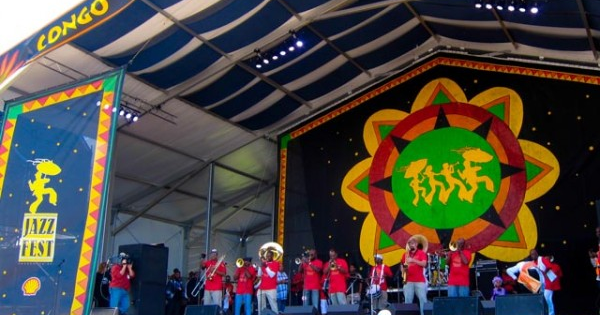JazzFest Large and Small
You may complain about what it’s become, but you needn’t look hard to find local music and culture

JazzFest—or, the “New Orleans Jazz and Heritage Festival presented by Shell,” as nobody but the local papers calls it—kicked off last Friday and, after a three-day hiatus, will finish up this Sunday. The first weekend was notably damp, with biblical downpours on both Friday and Saturday. The festival is staged on the grounds of an off-season racetrack, which meant that even on sunny Sunday, wandering parts of the grounds meant dealing with ankle-deep Super Glue-quality mud redolent of the pasture. And by that I don’t mean spring blossoms.
Still, the music was outstanding, as always, and shared hardship can help a crowd cohere. The grousing I heard, from friends and others, was similar to what I’ve been hearing for the 10 years I’ve been attending. That JazzFest is no longer the funky, local festival it was when founded in 1970 in a park downtown. That it no longer costs $5 to get in. (It’s now $70 at the gate.) That it’s no longer a local event, but one stop along the global commercial festival circuit. (This year’s headliners include a minor British invasion of yesteryear, led by The Who, Steve Winwood, and Elton John. New Orleans acts do perform throughout the festival, though not always on the main stages.) That at times it can all feel like a culture zoo, with bands and events removed from their natural habitat for the convenience of gawking tourists.
It’s true: the second-line parades led by local brass bands through the festival grounds can feel stilted, followed as they are by bewildered people who seem unsure whether they should be dancing or clapping or what. And Mr. Okra—a produce vendor who still cruises through New Orleans neighborhoods in his pickup truck singing out through a megaphone what he’s got in stock—here sits impassively in his driver’s seat, a stationary target for festivalgoers looking for a memorable selfie.
Then there’s the Economy Hall Tent, named after a famous and long-gone social club and dance hall. It offers a nonstop lineup of traditional New Orleans jazz, and I often park myself there for long stretches to marvel at the virtuosity of the bands. But sometimes I have to contend with an aggressive cadre of colorfully clad seniors who arrive early to stake claim to chairs—like resort guests who territorially mark “their” beach chairs with towels first thing every morning—then spend much of the day out of their chairs parading around and waving white handkerchiefs and little umbrellas, often second-lining to music that was never meant to be second-lined. I find myself disliking them for turning New Orleans culture into a goofy cartoon, and then I dislike myself for disliking them. After all, they’re obviously having a grand time.
When it comes to events, New Orleans does two scales well: very small and very large. The small has always appealed to me more. The façades of the tiny shotgun houses in older neighborhoods are intricate and compact, fit for elfin gentry. Chefs at even the best restaurants don’t act as much like celebrities as your next-door neighbor. When you go out to hear music, it’s rarely in cavernous clubs where musicians play off a set list, but more often in cramped bars where you need to be alert if you don’t want to be whacked by a trombone slide, with performers who decide what to play next based on the mood of the moment.
JazzFest on the other hand is heroically sized—over the course of a week, it attracts upwards of 400,000 attendees, which is more than the city’s current population. It’s also impeccably well run. Acts begin and end on time, food booths efficiently serve up gazillions of crawfish and gallons of gumbo. In the process, it may render New Orleans into a culture cartoon, but it’s a pretty wonderful cartoon, and it opens a door to a world many haven’t experienced. Someone might come for Tony Bennett and Lady Gaga (FYI: her eight outfits were amazing), but then get distracted while walking past the Rebirth Brass Band or The Deslondes, and decide then and there to return to New Orleans to track these musicians down in their native habitat. I’d wager that you can’t have a half-dozen bar conversations here without finding someone who flew in for JazzFest and essentially never left. Not necessarily because they loved JazzFest, but because it introduced them to a culture they came to love.
On the last Sunday, JazzFest traditionally celebrates local heroes by assigning them closing acts on the main stages. This year, it’s Trombone Shorty and Dr. John on either end of the racetrack. If you want to find me, though, I’ll be at the more low-key and relaxed setting of the Lagniappe Stage, where Bobby Lounge, a southern Louisiana original (think: Tom Lehrer of the trailer park), will play his rude and ribald barrelhouse piano music. I go most every year, and it’s the perfect transition back to the real world.

